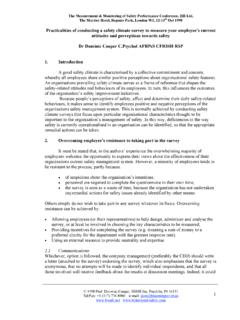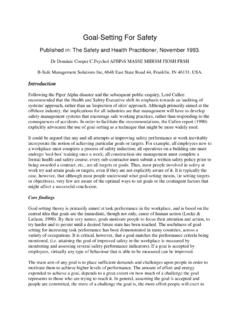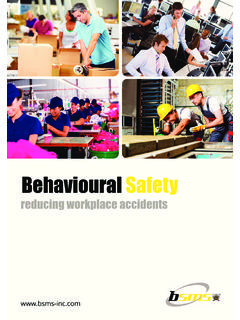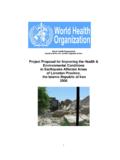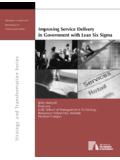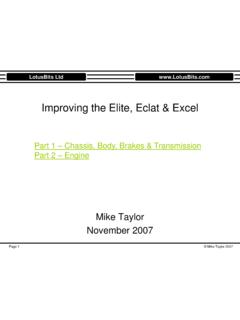Transcription of B-Safe
1 B-Safe Jnqspwjoh Tbgfuz Dvmuvsf B Qsbdujdbm Hvjef Epnjojd Dppqfs Bqqmjfe Cfibwjpvsbm Tdjfodft Ivmm . )xxx/ctbgf/dp/vl*. Improving Safety Culture: A Practical Guide by Dominic Cooper Copyright 2001 by Applied Behavioural Sciences Head office: 1060 Holderness Road, Hull, HU9 4AH. National 01482 708899. International (+44) 1482 708899. e-mail (for orders and customer service enquiries): Visit our Home Page on First published 1998 by John Wiley & Sons Ltd. The right of Dominic Cooper to be identified as Author of this work has been asserted by him in accordance with the Copyright, Designs and Patents Act 1988.
2 All Rights Reserved. No part of this publication may be reproduced, stored in a retrieval system, or transmitted, in any form or by any means, electronic, mechanical, photocopying, recording, scanning or otherwise, except under the terms of the Copyright, Designs and Patents Act 1988 or under the terms of a license issued by the Copyright Licensing Agency, 90 Tottenham Court Road, London, UK W1P 9HE, without the permission in writing of the Publisher. Library of Congress Cataloging-in-Publication Data Cooper, Dominic. Improving safety culture : a practical guide / Dominic Cooper.
3 P. cm. Includes index. ISBN 0-471-95821-2 (paper). 1. Industrial safety -Management. I. Title. 1997. 08 -dc21 97 25693. CIP. British Library Cataloguing in Publication Data A catalogue record for this book is available from the British Library ISBN 1 901128 02 4. Typeset in Palatino & Skia by The Dzine Partnership, London: CONTENTS. Preface iii Acknowledgments viii 1 The Concept of Safety Culture 1. Introduction 1. The Evolution of the Concept of Safety Culture 3. Accident Causation Models 5. Organisational Characteristics of a Good Safety Culture 13.
4 Towards a Model of Safety Culture 14. How to Read This Book 26. Summary 27. Section One The Immediate Level of Effort 29. 2 Effective Leadership for Developing a Safety Culture 30. Introduction 30. Leadership 30. Strategic Planning 32. Problem-solving 37. Increasing People's Commitment to a Decision 43. Strategic Communications 51. Resistance to Change 54. 3 Methods of Evaluating and Integrating Organisational Systems 60. Introduction 60. Identifying structural problems 61. Using Workflow Analysis to Identify Specific Information-sharing Problems 62.
5 Job Characteristics Analysis 67. Work group Communications 75. Job Analysis 86. Work Safety Analysis 92. 4 Developing Risk Control Systems 94. Introduction 94. What is Risk Assessment? 94. Risk Control Measures 103. Section Two The Intermediate Level of Effort 111. 5 Integrating Management Information Systems 112. Jnqspwjoh Tbgfuz Dvmuvsf qbhf j Contents Introduction 112. Management Control Mechanisms 112. Information Requirements 119. System Characteristics 125. Developing an Integrated Management Information System 130. 6 Safety Management System Auditing 144.
6 Introduction 144. Developing a Safety Audit System 144. Establishing the Need for Safety Audits 146. Types of Safety Audit 147. Audit Frequency 150. Standards Required for Planning and Executing the Audit Programme 153. Audit Elements 157. Auditing Practice 163. Audit Follow-up 175. Reviewing the Audit System 175. Section Three The Ultimate Level of Effort 177. 7 Safety Propaganda and Safety Training 178. Introduction 178. Safety Information Campaigns 178. Safety Training 182. 8 Measuring Safety Climate 200. Introduction 200.
7 Safety Attitudes 200. Safety Climate 204. Developing a Survey Instrument 217. 9 Improving Behavioural Safety 225. Introduction 225. Why Focus on Unsafe Behaviour? 226. Why do People Behave Unsafely? 228. How is Unsafe Behaviour Prevented? 230. Achieving Improvements in Safety Behaviour 233. Does it Work? 233. Putting a Behavioural Safety Initiative into Operation 234. Additional Reading 254. Index 255. qbhf jj Jnqspwjoh Tbgfuz Dvmuvsf Qsfgbdf In recent years companies have begun to recognise the important contribution that an effective safety culture can make to the control of their ongoing operational costs and the efficiency of their ongoing operations.
8 Much of this is due to the recent introduction of EC goal-setting legislation that places the onus on organisations to identify and properly manage the risks created by their activities. Many organisations have realised that this provides the perfect opportunity for them to streamline their operational processes and optimise the associated management and control systems. In practice, it has also meant that responsibility for health, safety and environmental issues has become firmly established as an integral part of the line management function, rather than being the sole domain of the safety officer (or safety department as has traditionally been the case).
9 Therefore, now more than ever before, all levels of line management need to possess a much greater knowledge of how to develop and implement high quality safety management systems. They also need to know how to manage safety on a day to day basis throughout their areas of responsibility. The traditional `policing' role of the safety practitioner has also changed. No longer a mere safety officer, the safety practitioner's role is now that of a high-level internal consultant. They are expected to offer independent advice to senior management on the development of the organi- sation's safety policies and their short, medium and long term strategic objectives for creating and maintaining a positive safety culture.
10 In addition, they are expected to advise line-managers on both the development and implementation of appropriate control and monitoring systems and the review of ongoing safety performance, while at the same time conducting independent reviews of the whole safety management system. To fulfil these functions in an effective manner, it is self- evident that safety practitioners must be authoritative all rounders. While possessing an awareness of all aspects of safety per se, he or she will also need to: have an up-to-date and in-depth appreciation of all aspects of management and management systems be experienced in problem-solving and decision-making be highly aware of the effects organisational change and development issues ( project management, team-working, downsizing, contracting out, etc.)
